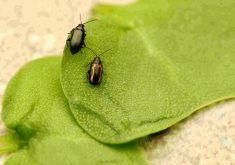After a cool, wet start, the pendulum of summer weather has swung to the other extreme.
The latter part of July was hot and dry, with several heat warnings, and the province’s oilseed experts worry that it will affect canola yields.
The July 30 Manitoba Agriculture crop report noted that early seeded canola crops were well into pod filling and flower drop was complete, but fields seeded later were in full flower.
Read Also

Manitoba boosts stake in cereals centre to $23.5 million
Premier Wab Kinew said the additional project funds will help ‘Trump-proof’ the provincial economy.
Wet weather earlier in the year raised the potential threat of disease and, for later-seeded fields, fungicide was still being applied.
Why it matters: As the growing season progresses, Manitoba’s canola farmers grapple with dual threats of excess moisture and extreme heat.
The summer has ticked two major weather phenomena boxes that typically get experts worried about yield: excess moisture, which the province notes is still affecting multiple crops, and heat stress, when temperatures rise above 28 C.
Water-logged plants are susceptible to stress from lack of air movement if soil pores fill with water, said Sonia Wilson, oilseeds specialist with Manitoba Agriculture. Producers may first notice purple discolouration on the plant if this is the case.
“Oxygen is really important, as well as water, to the plants’ life cycle, especially with older plants (that are) using a lot of water,” she said during a July 31 Crop Talk webinar hosted by Manitoba Agriculture.
Plants that grow in such conditions can experience crumpled stems, which can also be a sign of nutrient deficiency.
“As we get a bit older plants, you’ll see more of the crumpling of stems and it’s hard to distinguish some of these symptoms versus nutrient deficiency. They can actually be happening hand in hand,” Wilson said.
Lack of oxygen taken up by plant roots affects the entire plant system, decreasing root respiration and growth. Effects can be seen in only a few days.
“It’s just going to … [move] into those reproductive focused stages stressed and then move right into flowering, rather than having taken the time … to really grow those large leaves and have that sort of energy in those leaves, which is later really going to be used during the seed filling of the pods,” Wilson said.
The Canola Council of Canada’s website states that younger seedlings are considerably more vulnerable than older plants. Studies in China show seedlings are most susceptible to waterlogging, followed by stem elongation and pod formation. The flowering stage is the least vulnerable. Waterlogging can also trigger premature bolting and flowering as a survival mechanism in response to stress.
After the crop begins to recover and excess water recedes, the canola council says producers may want to consider another fertilizer application. A hit of nitrogen, phosphorus and potassium and/or growth regulators has been shown to alleviate waterlogging stress in canola, but no trials have been conducted in Western Canada to determine whether these treatments can rescue waterlogged canola.
If a canola field is still viable after flooding, applying fertilizer to support recovery and yield might be beneficial.
Bringing the heat
Excess heat can create just as many problems. Heat stress can severely affect the fertility of canola flowers, leading to reduced pod and seed production. The canola council notes that hot days between 28 and 30 C, mixed with warm nights above 16 C between bud and mid-flowering, can cause flowers to abort.
The yield impact can be devastating.
“Cool nights offer some recovery from hot days,” the webpage notes. “Warm nights do not provide a recovery period, and more flowers are aborted, producing blanks along the stem. Even with a few days of heat, it can take a week for hormone balance and regular pod formation to return.”
The council warns producers to watch for shortened stamens below the level of the petals. Those blooms may be heat damaged and if so, likely will not create a pod.
In growth cabinet experiments, canola grown under high temperatures produced short, plump pods that contained no seeds, the council noted. These seedless pods may have resulted from parthenocarpy, a condition where pollination stimulates ovary development but fertilization fails, preventing seed formation. Canola pollen tubes grew best between 20 and 23 C.
Heat stress affects both fertilized flowers and those yet to be fertilized. It also reduces pollen viability, leading to pollination failure and causing floral buds, flowers and pods to shed.
Beyond short stamens, canola that bloomed during heat can show stunted flowers and shriveled petals.
Heat also affects development of pollen and ovules, embryo sac differentiation, fertilization and post-fertilization structures such as endosperm and embryo growth, the council notes.
Some research has looked at applying boron to protect against heat stress, but extension staff say that more reliable methods include seeding earlier or choosing more heat-tolerant canola hybrids.
Seeding early comes with it’s own risks, including higher threat of frost, more seedling disease and more flea beetle pressure if early crops don’t establish quickly in cooler soils.
When it comes to heat-tolerant hybrids, growers should look at cultivar comparison data and plot trials for more information or choose earlier-maturing hybrids that also flower earlier, experts advise.
















